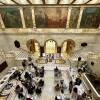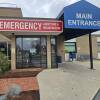It’s been five years since the COVID-19 lockdown, and much of what changed during the pandemic has slowly returned to the pre-2020 baseline. But some aspects of how people live, work, learn and interact with each other have experienced lasting changes.
“Remote work is probably the biggest, more permanent shift that we’ve seen from the pandemic,” Caitlin Gilbert, a data reporter for the Washington Post, said on GBH’s Under the Radar. “Folks thought maybe this would be a more temporary shift. But even the most recent work-from-home data suggest that more than a third of employed folks are working from home. Obviously, some jobs cannot be done remotely, but this is a pretty significant shift. Hybrid work is here to stay.”
Another permanent shift? Online commerce.
“E-commerce, in general, has completely blown up and has been really resilient across retail lanes, with a huge rise in self-care,” Gilbert said. “The beauty industry has really flourished in spite of the pandemic.”
The continuing popularity of hybrid work and e-commerce has already had an effect in regards to office and retail space, said Sara Jensen Carr, an associate professor of architecture, urbanism and landscape at the School of Architecture at Northeastern University. These empty commercial buildings could be used as much needed housing in many downtown areas, Carr said. It’s also an opportunity for people and city planners to reinvest in their hyperlocal communities.
“We’re still not investing in what we would call those 'third places,' or places where people can socialize and see each other and meet each other face to face again,” Carr said. “In the early days of the pandemic, there was a real hope in investment in those places, whether they be parks or whether they be schools, or whether they just be town squares. And now that we’re moving past that, I think we as experts, people that shape towns, people that live in their towns, we should be looking forward and looking at this as an opportunity to relocalize.”
Carr said previous pandemics and epidemics — like tuberculosis in the 1900s, the Spanish flu of 1918, cholera and yellow fever — massively shaped city planning, leading to improvements in building codes, waste management and the creation of large public parks, like Central Park in New York City and the Emerald Necklace in Boston. History shows that big steps in city planning lead by public-health efforts are successful and long-lasting.
Dr. Nicholas Christakis, a social scientist and physician at Yale University, said looking at history is imperative to understanding where the world stands now after the coronavirus pandemic.
“Plagues are not new to our species; they’re just new to us,” Christakis said. “Ultimately I think we’re going to return mostly to baseline, because what happens with plagues is that there is a kind of regime of public forgetting and private remembrance. Each of us remembers our plague experience, but the country as a whole kind of wants to forget and put it behind us. And we’re already beginning to see that.”
Guests
- Dr. Nicholas Christakis, social scientist and physician at Yale University, director of the Human Nature Lab, director of the Yale Institute for Network Science, author of “Apollo’s Arrow: The Profound and Enduring Impact of Coronavirus on the Way We Live.”
- Sara Jensen Carr, associate professor of architecture, urbanism, and landscape at the School of Architecture at Northeastern University where she holds affiliate appointments at the Global Resilience Institute and Institute for Health Equity and Social Justice Research.
- Caitlin Gilbert, data reporter covering health, science and wellness for the Washington Post.






